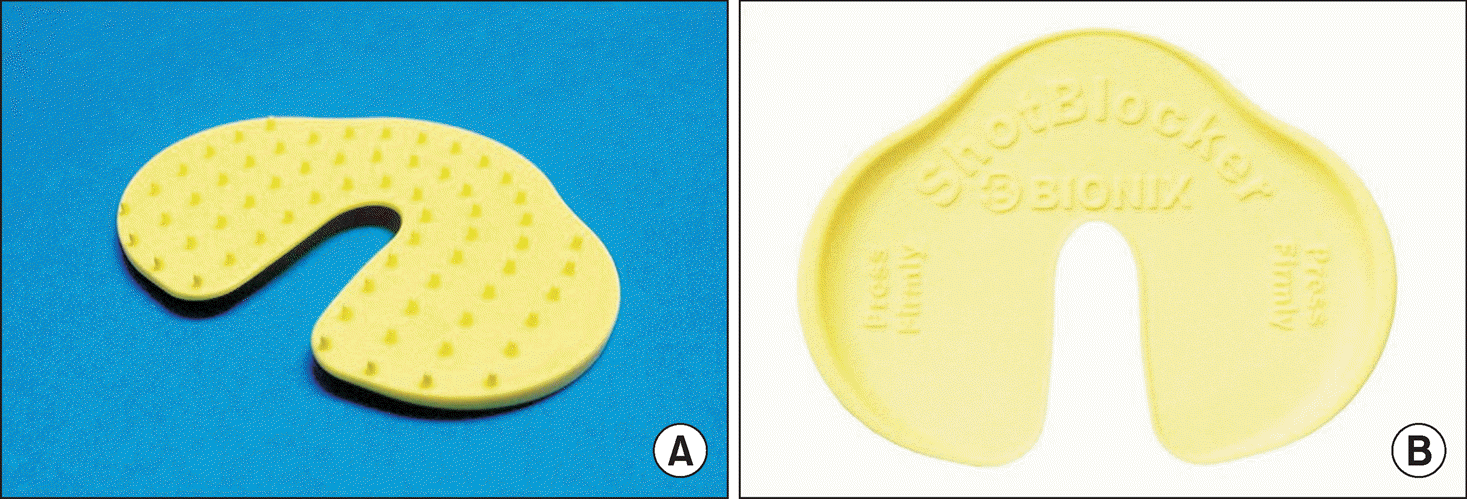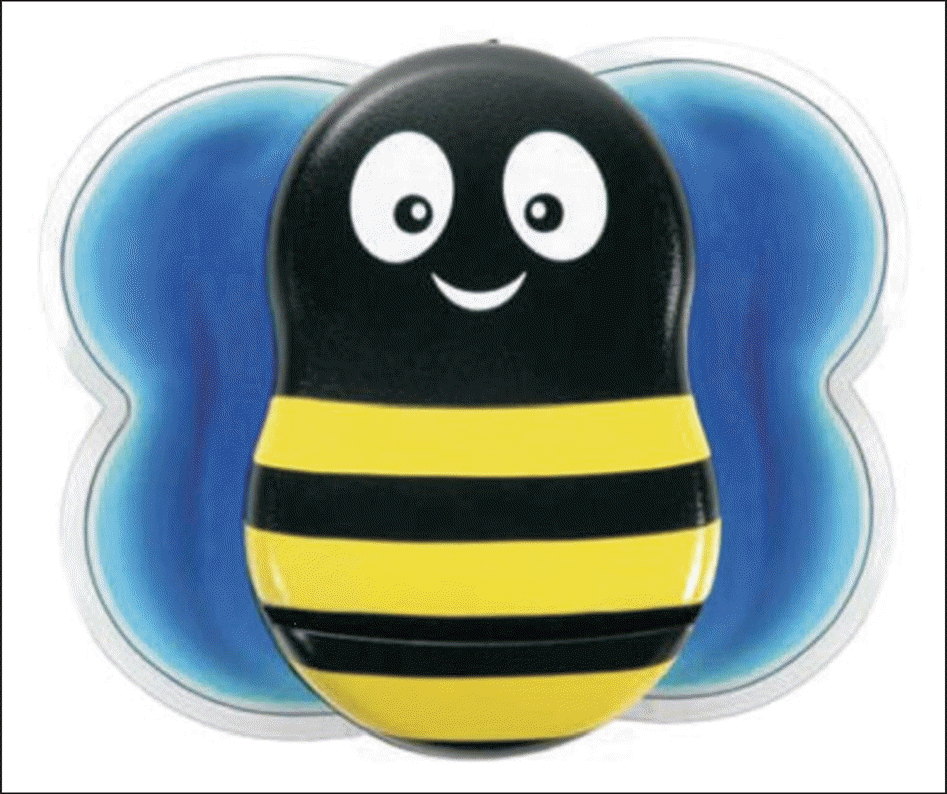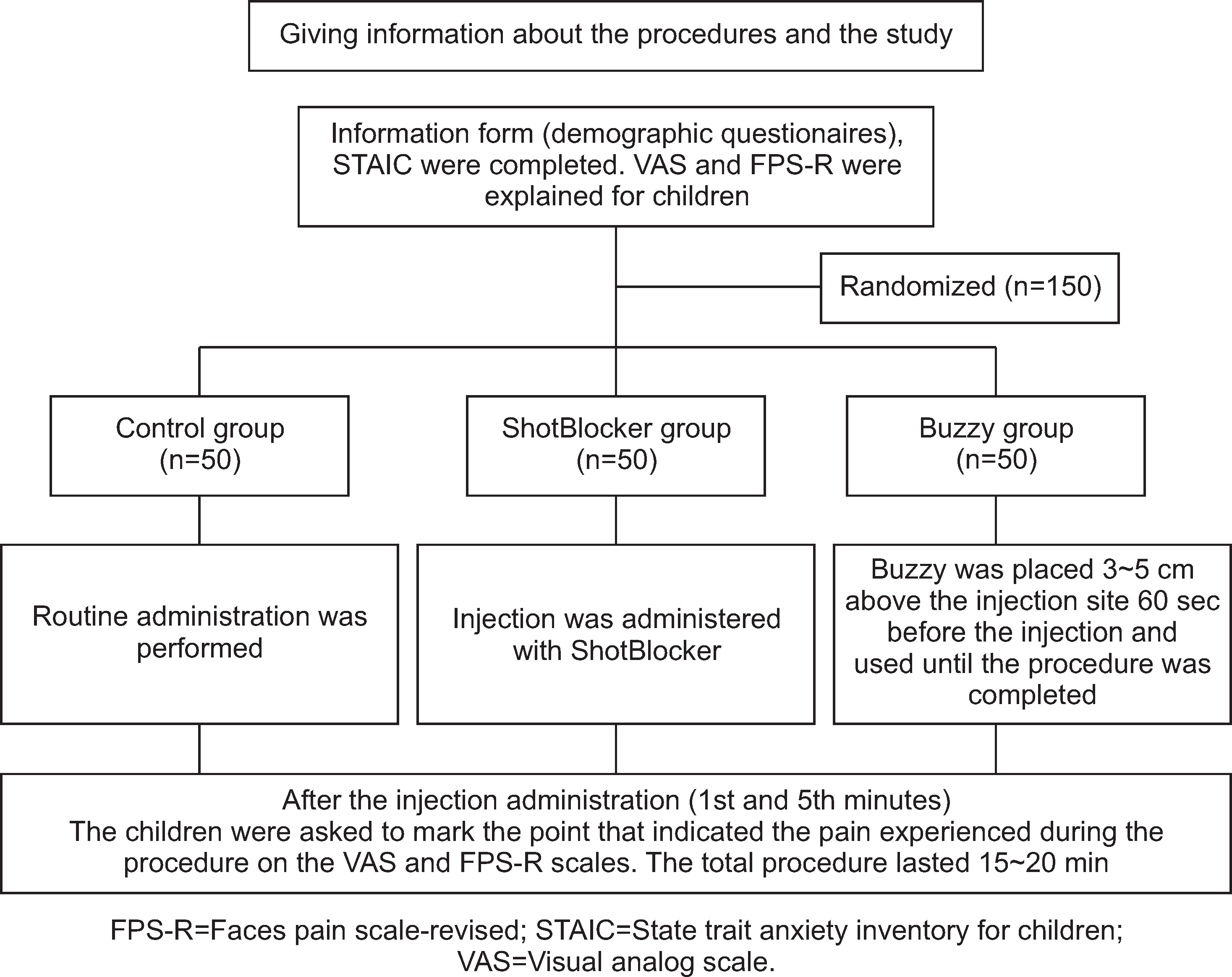Abstract
Purpose
To investigate the effect of Buzzy® and ShotBlocker® on reducing pain induced by intramuscular penicillin injections in children.
Methods
This was a randomized controlled study. A total of 150 Turkish children aged 7~12 years who presented to our pediatric emergency clinic and met the inclusion criteria were recruited. The children were randomly assigned to each group (control=50, Buzzy®=50, ShotBlocker®=50). Data were collected using an information form, the State-Trait Anxiety Inventory for Children, Visual Analog Scale, and Faces Pain Scale-Revised.
Results
The children in the control group had significantly higher pain scores during the penicillin injection than the children in the ShotBlocker® and Buzzy® groups. The children in the Buzzy® group had significantly less pain than the children in both the ShotBlocker® and control groups (p<.001).
Go to : 
References
1. International Association for the Study of Pain (IASP). IASP terminology [Internet]. Washington, D.C.: IASP;c2015. [cited 2015 Jul 31; Updated 2017 Dec 14]. Available from:. http://www.iasp-pain.org/Education/Content.aspx?ItemNum-ber=1698.
2. Kara D. The methods for reducing pain due to intramuscular injection. Gümüşhane University Journal of Health Sciences. 2013; 2(2):275–289.
3. Çelik N. Investigation of the effect of “ShotBlocker” on reducing pain and anxiety associated with intramuscular injection [dissertation]. İzmir: Ege University Institute of Health Sciences;2012. p. 1–185.
4. Mutlu B, Balcı S. Effects of balloon inflation and cough trick methods on easing pain in children during the drawing of venous blood samples: A randomized controlled trial. Journal for Specialists in Pediatric Nursing. 2015; 20(3):178–186. https://doi.org/10.1111/jspn.12112.

5. Committee on Psychosocial Aspects of Child and Family Health; Task Force on Pain in Infants, Children, and Adolescents. The assessment and management of acute pain in infants, children, and adolescents. Pediatrics. 2001; 108(3):793–797.
6. Redfern RE, Chen JT, Sibrel S. Effects of thermomechanical stimulation during vaccination on anxiety, pain, and satisfaction in pediatric patients: A randomized controlled trial. 2018; 38:1–7. https://doi.org/10.1016/j.pedn.2017.09.009.
7. Khorshid L. Innovations in nursing, and nursing informatics developments. Poster session presented at:the 14th National Nursing Congress Book. 2013. Oct 25-27; Muğla, Turkey. 35–46.
8. Özusta Ş. State-trait anxiety inventory for children: A study of reliability and validity. Turkish Journal of Psychology. 1995; 10:32–44.
9. Drendel AL, Kelly BT, Ali S. Pain assessment for children: Overcoming challenges and optimizing care. Pediatric Emer- gency Care. 2011; 27(8):773–781. https://doi.org/10.1097/PEC.0b013e31822877f7.
10. Huguet A, Stinson JN, McGrath PJ. Measurement of self-reported pain intensity in children and adolescents. Journal of Psychosomatic Research. 2010; 68(4):329–336. https://doi.org/10.1016/j.jpsychores.2009.06.003.

11. Cobb JE, Cohen LL. A randomized controlled trial of the Shot-Blocker for children’s immunization distress. The Clinical Journal of Pain. 2009; 25(9):790–796. https://doi.org/10.1097/AJP.0b013e3181af1324.

12. Drago LA, Singh SB, Douglass-Bright A, Yiadom MY, Baumann BM. Efficacy of ShotBlocker in reducing pediatric pain associated with intramuscular injections. The American Journal of Emergency Medicine. 2009; 27(5):536–543. https://doi.org/10.1016/j.ajem.2008.04.011.

13. Hughes T. Providing information to children before and during venepuncture. Nursing Children and Young People. 2012; 24(5):23–28. https://doi.org/10.7748/ncyp2012.06.24.5.23.c9142.

14. Zempsky WT. Optimizing the management of peripheral venous access pain in children: Evidence, impact, and implementation. Pediatrics. 2008; 122(Suppl 3):S121–S124. https://doi.org/10.1542/peds.2008-1055c.

15. Sinha M, Christopher NC, Fenn R, Reeves L. Evaluation of nonpharmacologic methods of pain and anxiety management for laceration repair in the pediatric emergency department. Pediatrics. 2006; 117(4):1162–1168. https://doi.org/10.1542/peds.2005-1100.

16. Bautista EH. Parenteral injection massage: Bioavailability and adverse effects, a systematic review. International Journal of Nursing. 2013; 2(1):1–7.
17. Taddio A, lIersich AL, Ipp M, Kikuta A, Shah V; HELPinKIDS Team. Physical interventions and injection techniques for reducing injection pain during routine childhood immunizations: Systematic review of randomized controlled trials and quasi-randomized controlled trials. Clinical Therapeutics. 2009; 31(Suppl B):S48–S76. https://doi.org/10.1016/j.clinthera.2009.07.024.
18. Şahin M. Effect of Buzzy® application on pain and injection satisfaction in adult patients who received intramuscular injection [master’s thesis]. İzmir: Ege University Institute of Health Sciences;2013. p. 1–73.
19. Hasanpour M, Tootoonchi M, Aein F, Yadegarfar G. The effects of two non-pharmacologic pain management methods for intramuscular injection pain in children. Acute Pain. 2006; 8(1):7–12. https://doi.org/10.1016/j.acpain.2005.11.001.

20. Russell K, Nicholson R, Naidu R. Reducing the pain of intramuscular benzathine penicillin injections in the rheumatic fever population of Counties Manukau District Health Board. Journal of Pediatrics and Child Health. 2014; 50(2):112–117. https://doi.org/10.1111/jpc.12400.

21. Taddio A, Ho T, Vyas C, Thivakaran S, Jamal A, Ilersich AF, et al. A randomized controlled trial of clinician-led tactile stimulation to reduce pain during vaccination in infants. Clinical Pediatrics. 2014; 53(7):639–644. https://doi.org/10.1177/0009922814526976.

22. Sahiner NC, Bal MD. The effects of three different distraction methods on pain and anxiety in children. Journal of Child Health Care. 2016; 20(3):277–285. https://doi.org/10.1177/1367493515587062.

23. Susam V, Friedel M, Basile P, Ferri P, Bonetti L. Efficacy of the Buzzy System for pain relief during venipuncture in children: A randomized controlled trial. Acta Biomed for Health Professions. 2018; 89(6 Suppl):6–16. https://doi.org/10.23750/abm.v89i6-S.7378.
24. Hollins M, McDermott K, Harper D. How does vibration reduce pain? Perception. 2014; 43(1):70–84. https://doi.org/10.1068/p7637.

25. Inal S, Kelleci M. Distracting children during blood draw: Looking through distraction cards is effective in pain relief of children during blood draw. International Journal of Nursing Practice. 2012; 18(2):210–219. https://doi.org/10.1111/j.1440-172X.2012.02016.x.

26. Guevarra MAD. Efficacy of ShotBlocker™ in reducing pain associated with intramuscular injections in pre-school children [Internet]. Toledo (OH): Bionix Development Corporation;c2003. [cited 2018 Aug 8]. Available from:. https://www.bionix.com/healthathome/wp-content/uploads/sites/3/2016/02/Effi-cacy_of_ShotBlocker_Guevarra_MD.pdf.
27. Gundrum T, Sherman C, Ruhlman S. Assessment of discomfort with usual immunization practice compared to the use of usual practice and ShotBlocker [Internet]. Toledo (OH): Bionix Development Corporation;c2005. [cited 2018 Aug 8]. Available from:. https://www.bionix.com/medicaltech/studies/assessment-of-discomfort-with-usual-immunization-practice-compared-to-the-use-of-usual-practice-and-shot-blocker/.
28. Mennuti-Washburn JE. Gate control theory and its application in a physical intervention to reduce children’s pain during immunization injections [master’s thesis]. Atlanta (GA): Georgia State University;2007. p. 1–58.
29. Foster R, Eberhart T, Zuk J, Finn C. Is the ShotBlock-er effective in reducing immunization pain? Research News. 2005; 12:1–2.
30. Aker A, Tibet H, Doğan H, Berberoğlu OE, Çelikbilek Erkasap P. [Vademecum: Modern Ilaç Rehberi]. 13th ed. İstanbul: Medical Tribune;2014. p. 20–35. Turkish.
Go to : 
Table 1.
Comparison of Socio-Demographic Characteristics according to Groups (N=150)
| Characteristics | ShotBlocker® | Buzzy® | Control | Total | Test Value | p |
|---|---|---|---|---|---|---|
|
(n=50) |
(n=50) |
(n=50) |
(n=150) |
|||
| M±SD | M±SD | M±SD | M±SD | |||
| Average age (yr) | 8.66±1.77 | 8.98±1.82 | 9.12±2.03 | 8.92±1.87 | 0.82† | .456 |
| Number of penicillin injections | 2.78±2.26 | 2.82±1.85 | 3.32±2.43 | 2.97±2.19 | 2.40†† | .301 |
| State-Trait Anxiety Inventory | 38.50±5.47 | 37.74±6.07 | 40.16±6.24 | 38.80±5.99 | 2.17† | .118 |
| (before the procedure) | ||||||
|
|
||||||
| n (%) | n (%) | n (%) | n (%) | |||
|
|
||||||
| Sex | ||||||
| Female | 23 (46.0) | 25 (50.0) | 21 (42.0) | 69 (46.0) | 0.64§ | .725 |
| Male | 27 (54.0) | 25 (50.0) | 29 (58.0) | 81 (54.0) | ||
Table 2.
Comparison of the First and Fifth-Minute Visual Analog Scale (VAS) Mean Scores of the Children according to Groups (N=150)
| Scale |
ShotBlocker® (n=50) |
Buzzy® (n=50) |
Control (n=50) |
Test Value | p |
|---|---|---|---|---|---|
| M±SD | M±SD | M±SD | |||
| VAS (1st min.) | 6.36±3.24 | 3.68±3.05 | 7.34±3.11 | 30.06† | <.001 |
| VAS (5th min.) | 3.38±2.94 | 1.68±2.28 | 4.88±3.24 | 26.45† | <.001 |
| Mean Score Difference | -2.90±1.59 | -2.00±1.67 | -2.46±1.69 | 9.33† | .009 |
| Test Value | -6.06†† | -5.47†† | -5.81†† | ||
| p | <.001 | <.001 | <.001 |
Table 3.
Comparison of the First and Fifth-Minute Faces Pain Scale-Revised (FPS-R) Mean Scores of the Children according to Groups (N=150)
| Scales | ShotBlocker® | Buzzy® | Control | Test Value | p |
|---|---|---|---|---|---|
|
(n=50) |
(n=50) |
(n=50) |
|||
| M±SD | M±SD | M±SD | |||
| FPS-R (1st min.) | 6.24±3.20 | 3.64±3.10 | 7.36±3.09 | 30.64† | <.001 |
| FPS-R (5th min.) | 3.24±2.96 | 1.52±2.23 | 4.84±3.29 | 27.17† | <.001 |
| Mean Score Difference | -2.92±1.48 | -2.12±1.73 | -2.52±1.71 | 8.79† | .012 |
| Test Value | -6.10†† | -5.85†† | -5.83†† | ||
| p | <.001 | <.001 | <.001 |




 PDF
PDF ePub
ePub Citation
Citation Print
Print





 XML Download
XML Download